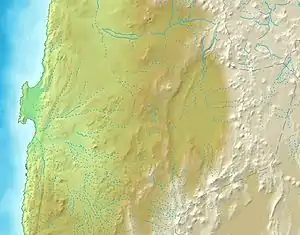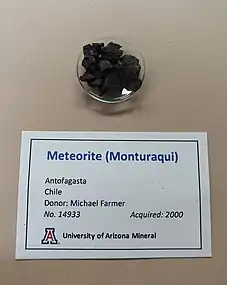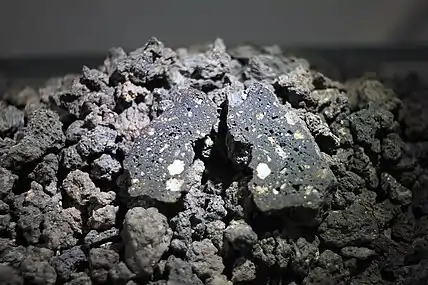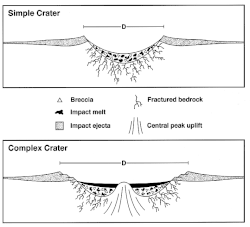| Monturaqui | |
|---|---|
 | |
| Impact crater/structure | |
| Diameter | 350 m × 370 m (1,150 ft × 1,210 ft) |
| Depth | 34 m (112 ft) |
| Impactor diameter | 15 m (49 ft) |
| Age | 663,000 ± 90,000 years ago |
| Exposed | Yes |
| Drilled | No |
| Bolide type | Group 1 octahedrite |
| Location | |
| Coordinates | 23°55′39″S 68°15′42″W / 23.92750°S 68.26167°W[1] |
| Country | Chile |
| State | Antofagasta Region |
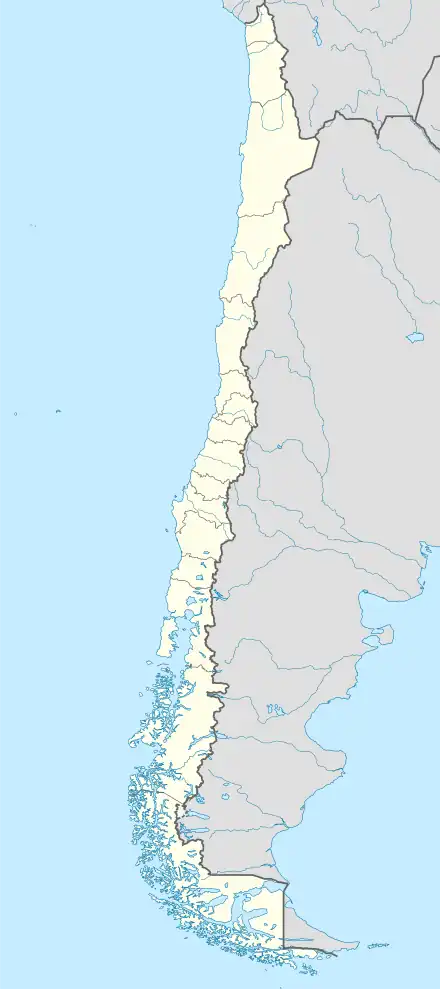 | |
Monturaqui is an impact crater in Chile. It lies south of the Salar de Atacama and was formed 663,000 ± 90,000 years ago by the impact of an IAB meteorite. It is 350 m × 370 m (1,150 ft × 1,210 ft) wide and 34 m (112 ft) deep and contains a salt pan. Only a few remnants of the meteorite that formed the crater have been collected, with most of the rocks being of local origin. The crater was discovered in 1962 and identified as an impact crater in 1966.
Human history
The crater was first suspected to be an impact crater in 1962,[2] when it was found on aerial images. After geologic research on the site found evidence of the impact event,[3] it was identified as an impact crater in 1966.[4] The crater has not been drilled.[5] Its name is derived from the mountain range where it is located[3] and from the town of Monturaqui 70 km (43 mi). The closest town is Peine, 35 km (22 mi) northeast of the crater.[6]
An old Inka road, which goes from the Pacific Ocean to San Pedro de Atacama and further to Argentina, runs 100–200 m (330–660 ft) from the crater.[7][8] The crater has been deemed by Stanislav Kaniansky and Kristian Molnár to be one of the "most impressive" in the world[9] and has a high scenic and historical value.[10] The Chilean Geological Society has defined it as one of the geosites of Chile,[11] although such a classification has no legal effect[12] and the crater is threatened by erosion caused by vehicles and the over-collection of rocks.[10] In 2017, several Chilean organizations and the community of Peine petitioned the Chilean government to declare the site a historic monument.[13] Monturaqui crater is a tourist attraction in the area.[14]
Geography and geomorphology
Monturaqui lies in a remote region of the Atacama Desert[15] south of the Salar de Atacama, in the "precordillera". The city of Antofagasta lies 200 km (120 mi) northwest of the crater.[4] Administratively, the crater is in the Antofagasta Region.[11]
Monturaqui is a nearly circular,[16] well-preserved 350 m × 370 m (1,150 ft × 1,210 ft) wide and 34 m (112 ft) deep impact crater.[4] It has the shape of a bowl[15] and is elongated in northwest–southeast direction.[1] The height of its rim ranges between 16–48 m (52–157 ft)[17] with the southern rim being about 10–15 m (33–49 ft) higher than the northern. Sedimentation in rain-fed ponds has left a 40 m2 (430 sq ft)[18] playa in the crater,[19] which lies in its northeastern quadrant[17] and is surrounded by lake sediments.[20] Bushes grow close to the salt pan deposits and it could be considered a "salt pan oasis".[19] The dry climate (the annual precipitation is less than 1 mm (0.039 in)[7]) means that water in the crater tends to evaporate.[21] A magnetic anomaly is associated with the crater.[22]
It is located at about 3,015 m (9,892 ft) elevation.[4] The terrain in the area consists of Paleozoic granites that are covered by Pliocene ignimbrites,[23] and slopes northward to the Salar de Atacama, thus explaining the tilt of the crater.[7] Dykes cut through the granitic units, and both ignimbrites and granites are faulted.[18] The impact primarily affected the granitic units[24] but both units are apparent in the crater walls and the ignimbrites cover the rim crest.[1]
Impact event
The impact has been dated with radiometric dating to have occurred about 663,000 ± 28,000 years ago.[25] Various surface exposure dating techniques yield ages of about 500,000–780,000 years.[1] Since then, erosion has altered the crater by depositing fluvial and mass wasting deposits in it,[26] gullying its sides[19] and by lowering the rim.[15] Originally, the Monturaqui crater was connected with the Campo del Cielo[6] or the Rio Cuarto impact structures in Argentina.[27]
The meteorite probably hit from the northwest[9] at an angle of 41° and was travelling at a velocity of about 15 km/s (9.3 mi/s).[1] Because of the elevation at which it hit the ground, the meteorite had traversed only a little more than half the atmosphere and thus had not lost as much mass as it would have had it hit ground at sea level.[16] The impact heated the ground to temperatures exceeding 1,400 °C (2,550 °F),[28] probably reaching 1,500–1,600 °C (2,730–2,910 °F),[29] and had an energy comparable to that of 2.2 Hiroshima bombs.[30] The formation of the crater disrupted the local drainage network, which redeveloped to run around the crater.[6]
Impactor
The impacting body was a metallic asteroid containing iron and nickel.[3] It has been identified as a group I octahedrite[4] and as an IAB meteorite[31] with a size of about 15 m (49 ft).[1]
Impact products
The impact has produced rocks such as impact glass,[32] coesite and shocked quartz; some rocks were completely melted during the impact[4] and others were turned to glass. Impact-generated rocks formed mostly from granite and meteorite material.[28] They are mostly found at the east-southeast side of the crater,[18] with lesser amounts on its inside.[33]
Only a few[33] or no fragments of the meteorite have been recovered.[15] Given the proximity of the crater to an old road, this may be due to traders and herdsmen removing meteorite fragments[8] but it may also be due to the metals being oxidized over time.[7] They include rocks called "iron shale",[34] they are magnetic indicating their origin in the meteorite.[8]
The nonoxidized parts consist of cohenite, rabdite, schreibersite and taenite. Other minerals are goethite, lepidocrocite, maghemite, pentlandite and reevesite.[35][36] Metallic spherules occur.[15] Fragments of the Monturaqui meteorite have been collected in the meteorite collection of "Giorgio Abetti" Astronomical Observatory and Museum, San Giovanni in Persiceto, Bologna, Italy.[37]
References
Citations
- 1 2 3 4 5 6 Peate et al. 2010, p. 1.
- ↑ Roeschmann & Rada 2000, p. 1.
- 1 2 3 Staffieri, Stelvio; Coletta, Alessandro; Battagliere, Maria Libera; Virelli, Maria (2019), Flamini, Enrico; Di Martino, Mario; Coletta, Alessandro (eds.), "Monturaqui, Chile", Encyclopedic Atlas of Terrestrial Impact Craters, Cham: Springer International Publishing, pp. 665–669, doi:10.1007/978-3-030-05451-9_185, ISBN 978-3-030-05449-6, S2CID 239286702, retrieved 2021-06-25
- 1 2 3 4 5 6 Ugalde, Valenzuela & Milkereit 2007, p. 2153.
- ↑ Rawal, J. J.; Ramadurai, S. (2007). "The role of Alfven drag in the planetary cratering process". Current Science. 93 (10): 1405. ISSN 0011-3891. JSTOR 24099350.
- 1 2 3 Sanchez & Cassidy 1966, p. 4895.
- 1 2 3 4 Buchwald 1975, p. 1405.
- 1 2 3 Sanchez & Cassidy 1966, p. 4893.
- 1 2 Kaniansky & Molnár 2015, p. 120.
- 1 2 Valenzuela & Benado 2018, p. 110.
- 1 2 Martínez, Tomás (2015). Estado actual de reconocimiento y distribución geográfica del Patrimonio Geológico Chileno (PDF). XIV Congreso Geológico Chileno (in Spanish). p. 423. Archived from the original (PDF) on June 25, 2021.
- ↑ Valenzuela & Benado 2018, p. 107.
- ↑ Valenzuela & Benado 2018, p. 111.
- ↑ "Bienestar humano y manejo sustenable en San Pedro de Atacama - Chile" (PDF). Millennium Ecosystem Assessment (in Spanish). Retrieved 25 June 2021.
- 1 2 3 4 5 Crósta et al. 2019, p. 196.
- 1 2 Bunch & Cassidy 1972, p. 95.
- 1 2 Sanchez & Cassidy 1966, p. 4891.
- 1 2 3 Ugalde, Valenzuela & Milkereit 2007, p. 2159.
- 1 2 3 Cockell, Charles S.; Lee, Pascal (August 2002). "The biology of impact craters – a review". Biological Reviews of the Cambridge Philosophical Society. 77 (3): 297. CiteSeerX 10.1.1.474.7227. doi:10.1017/S146479310100584X. PMID 12227518. S2CID 38544565.
- ↑ Crósta et al. 2019, p. 197.
- ↑ Cockell, Charles S.; Lim, Darlene S.S. (2005), Tokano, Tetsuya (ed.), "11 Impact Craters, Water and Microbial Life", Water on Mars and Life, Advances in Astrobiology and Biogeophysics, Berlin, Heidelberg: Springer, p. 269, Bibcode:2005wml..book..261C, doi:10.1007/978-3-540-31538-4_11, ISBN 978-3-540-31538-4, retrieved 2021-06-25
- ↑ Lamali, A.; Rochette, P.; Merabet, N.; Abtout, A.; Maouche, S.; Gattacceca, J.; Ferrière, L.; Hamoudi, M.; Meziane, E. H.; Ayache, M. (2016). "Geophysical and magneto-structural study of the Maâdna structure (Talemzane, Algeria): Insights on its age and origin". Meteoritics & Planetary Science. 51 (12): 2265. Bibcode:2016M&PS...51.2249L. doi:10.1111/maps.12715. ISSN 1945-5100. S2CID 132557766.
- ↑ Ugalde, Valenzuela & Milkereit 2007, p. 2157.
- ↑ Ugalde, Valenzuela & Milkereit 2007, p. 2162.
- ↑ Ukstins, Ingrid A.; Wartho, Jo-Anne; Cabrol, Nathalie A.; Grin, Edmond A.; van Soest, Matthijs C.; Biren, Marc B.; Hodges, Kip V.; Chong, Guillermo (1 February 2022). "An (U-Th)/He age for the small Monturaqui impact structure, Chile". Quaternary Geochronology. 67: 10. doi:10.1016/j.quageo.2021.101217. ISSN 1871-1014.
- ↑ Ugalde, Valenzuela & Milkereit 2007, pp. 2158–2159.
- ↑ Brobst, Donald Albert (1970). Barite: World Production, Reserves, and Future Prospects. U.S. Government Printing Office. p. 24.
- 1 2 Bunch & Cassidy 1972, p. 110.
- ↑ Roeschmann & Rada 2000, p. 3.
- ↑ Roeschmann & Rada 2000, p. 6.
- ↑ Kaniansky & Molnár 2015, p. 121.
- ↑ Schultz, Peter H.; Zárate, Marcelo; Hames, Willis E.; Harris, R. Scott; Bunch, T. E.; Koeberl, Christian; Renne, Paul; Wittke, James (May 2006). "The record of Miocene impacts in the Argentine Pampas". Meteoritics & Planetary Science. 41 (5): 768. Bibcode:2006M&PS...41..749S. doi:10.1111/j.1945-5100.2006.tb00990.x. hdl:11336/81867. S2CID 7590495.
- 1 2 Roeschmann & Rada 2000, p. 2.
- ↑ Buchwald 1975, p. 1406.
- ↑ Grieve, R. A. F.; Palme, H.; Plant, A. G. (1981-09-01). "Siderophile-rich particles in the melt rocks at the E. Clearwater impact structure, Quebec: Their characteristics and relationship to the impacting body". Contributions to Mineralogy and Petrology. 75 (3): 192. Bibcode:1981CoMP...75..187G. doi:10.1007/BF01166759. ISSN 1432-0967. S2CID 129916750.
- ↑ Bender Koch, C.; Buchwald, V. F. (1994). "Weathering of iron meteorites from Monturaqui, Chile". Meteoritics. 29."
- ↑ Levi-Donati, G. R. (July 1996). "The meteorite collection of "Giorgio Abetti"* Astronomical Observatory and Museum, San Giovanni in Persiceto, Bologna, Italy: An update of the catalog". Meteoritics & Planetary Science. 31 (S4): 185. Bibcode:1996M&PSA..31..181L. doi:10.1111/j.1945-5100.1996.tb02102.x.
General sources
- Buchwald, Vagn F. (1975), Iron Meteorites Supplement: Guadaloupe County - Monturaqui, University of California Press, retrieved 2021-06-25
- Bunch, T. E.; Cassidy, William A. (1972). "Petrographic and electron microprobe study of the Monturaqui impactite". Contributions to Mineralogy and Petrology. 36 (2): 95–112. Bibcode:1972CoMP...36...95B. doi:10.1007/BF00371181. S2CID 129022135.
- Crósta, A.P.; Reimold, W.U.; Vasconcelos, M.A.R.; Hauser, N.; Oliveira, G.J.G.; Maziviero, M.V.; Góes, A.M. (May 2019). "Impact cratering: The South American record—Part 2". Geochemistry. 79 (2): 191–220. Bibcode:2019ChEG...79..191C. doi:10.1016/j.chemer.2018.09.002. ISSN 0009-2819. S2CID 133991514.
- Kaniansky, Stanislav; Molnár, Kristian (2015). A new analysis of Monturaqui Meteorites (PDF). Proceedings of the IMC. Mistelbach.
- Peate, I. Ukstins; van Soest, M. C.; Wartho, J. A.; Cabrol, N.; Grin, E.; Piatek, J.; Chong, G. (2010). A novel application of (U-Th)/He geochronology to constrain the age of small, young meteorite impact craters: A case study of the Monturaqui crater, Chile (PDF). 41st Lunar and Planetary Science Conference.
- Roeschmann, C.; Rada, C. (2000). El impacto meteoritico de Monturaqui, Region de Antofagasta, Chile: Productos y procesos. 9th Chilean Geological Congress (in Spanish) – via Academia.edu.
- Sanchez, Joaquin; Cassidy, William (1966). "A previously undescribed meteorite crater in Chile" (PDF). Journal of Geophysical Research. 71 (20): 4891–4895. Bibcode:1966JGR....71.4891S. doi:10.1029/JZ071i020p04891. ISSN 2156-2202.
- Ugalde, Hernan; Valenzuela, Millarca; Milkereit, Bernd (2007). "An integrated geophysical and geological study of the Monturaqui impact crater, Chile". Meteoritics & Planetary Science. 42 (12): 2153–2163. Bibcode:2007M&PS...42.2153U. doi:10.1111/j.1945-5100.2007.tb01015.x. ISSN 1945-5100. S2CID 140698217.
- Valenzuela, Millarca; Benado, José (2018), Acevedo, Rogelio Daniel; Frías, Jesús Martínez (eds.), "Meteorites and Craters Found in Chile: A Bridge to Introduce the First Attempt for Geoheritage Legal Protection in the Country", Geoethics In Latin America, The Latin American Studies Book Series, Cham: Springer International Publishing, pp. 103–115, doi:10.1007/978-3-319-75373-7_7, ISBN 978-3-319-75373-7, retrieved 2021-06-25
External links
- Cukierski, Daniel Owen (2013-05-01). Textural and compositional analysis of Fe-Ni metallic spherules in impact melt from Monturaqui Crater, Chile (Theses and Dissertations). doi:10.17077/etd.xe5yzbjc.
- Kloberdanz, Christine Marie (2010). Geochemical analysis of the Monturaqui impact crater, Chile (Diss). University of Iowa.
